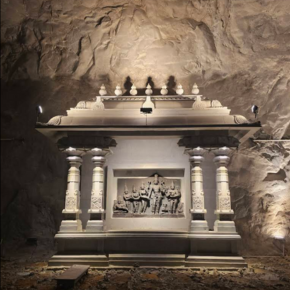Historical Significance of the Caves at Kailasagiri Hill Temple
The caves of Kailasagiri Hill Temple hold both architectural rarity and spiritual depth, making them an important heritage feature in Karnataka. This temple complex uniquely combines man-made rock-cut caves and natural cave formations, a pairing rarely seen in South Indian temple history.
The man-made caves were skillfully carved to create shrines dedicated to Lord Shiva (Chaturmukha Lingeshwara), Goddess Jagadambe (Parvati), and Lord Ganesha. These rock-cut sanctums showcase the mastery of ancient stone artisans who transformed solid rock into living spaces of worship, much like the early cave temples seen in Ellora and Badami. The most distinctive highlight is the Chaturmukha Lingam — a Shiva Lingam with four sculpted faces, each oriented in a different direction, symbolizing the omnipresence and all-encompassing nature of Lord Shiva.
In contrast, the natural caves remain largely untouched, preserving their original geological form. These caves are home to shrines of Ananta Padmanabha and Chenna Keshava, marking the rare co-existence of Shaivism and Vaishnavism within a single sacred complex. This reflects a period in temple history when devotional traditions blended harmoniously, welcoming followers of different faith paths under one spiritual roof.
Historically, hilltop cave temples like Kailasagiri served multiple roles — as places of pilgrimage, centers for meditation, and even shelters for wandering ascetics. The strategic location on a hill also symbolized the devotee’s spiritual ascent, with the climb itself becoming part of the worship ritual. Over the centuries, the caves have remained a testament to the spiritual devotion, artistic excellence, and cultural inclusivity of the region’s heritage.



